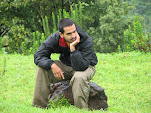Every human being is born
curious. It is this trait that has got us thriving and evolving to become the
dominant species in the world. Curiosity in itself is innocent. I too am
curious, curious to observe and explore the original treasures of the world.
Curiosity has four aspects, namely ‘How’, ‘Why’, ‘Where’ & ‘What’. ‘Where’
& ‘What’ make greater sense to me, serving a higher purpose. Of the many
adventures that have come my way, the one ‘Where’ & ‘What’ I will take you
along is the Bondla Wildlife Sanctuary in Goa for its avifauna.
Wintery mornings in Bondla WLS
are just magical. The silvery mist takes over the forest; the road is just
about visible, tempting and beckoning. As you pass through the archway of the
sanctuary, there is a notable transformation; the air is thicker, temperature
has dropped, the noise has ceased, you may have even grown wings, you surely
have gotten a ticket to a different world! You will want to tread carefully, so
as not to disturb its residents.
 As the mist clears, the forest
transforms once again. The Giant Wood Spider webs glisten in the morning sun,
the sun rays dance about, playing hide-and-seek with the rustling leaves and
tall trees. The foliage is dense and mysterious, the canopy magical, but the
real tales lie in the understory amongst the lianas and vines. The forest floor
is laid with leaves golden, upon which you dare tread, for they will trumpet
your presence to the inmates of the land, in loud crunch squeals.
As the mist clears, the forest
transforms once again. The Giant Wood Spider webs glisten in the morning sun,
the sun rays dance about, playing hide-and-seek with the rustling leaves and
tall trees. The foliage is dense and mysterious, the canopy magical, but the
real tales lie in the understory amongst the lianas and vines. The forest floor
is laid with leaves golden, upon which you dare tread, for they will trumpet
your presence to the inmates of the land, in loud crunch squeals.
 |
| Greater Racket-tailed Drongo |
But, if you
tread carefully, just pause momentarily and bow to listen, the whole jungle is
yours to see.
The morning songs will come strong, resonant through far and
near, and the first song that you hear may very well be of the Greater Racket-tailed
Drongo. A rhapsodic melody from a hidden perch, the tail visible as it sways to each note, like a conductor’s baton to every score. Behold the majestic bird, carefree in his forest; well, this is just the beginning as his band of boys will follow.
 |
| Velvet-fronted Nuthatch |
Orange Minivet,
Bronzed Drongo, Brown-cheeked Fulvetta, Velvet-fronted Nuthatche,
Black-
rumped Flameback and many more species follow. What we have encountered
is a hunting party, a mixed flock of birds, each benefitting from the others’
company, flittering and hopping, going about their business, foraging for
munchies from tree to tree, making merry of a beautiful morning. Well, they
will disappear as abruptly as they came, and then again, you will be left
behind with impressions dear, to continue along the road much taken, for the
untold tales lie in the lost trails.
 |
Great Indian Hornbill (Female)
|
If you are lucky, you will be graced by
the presence of many beauties, such as the Malabar Trogons, Black-hooded
Orioles, Hair-crested Drongos, Indian Blackbird, Green-Pigeons, Great Hornbills
and others.
The terrain at Bondla WLS is
unusually hilly, nesting amidst the Western Ghats, each bend taking a different
tone, the wavering light transforming the place with every passing minute. The
shadows can be wary, and if you are not curious enough, you will pass many a
beauties camouflaged in pure sight, unnoticed. At times, you seem to be
ascending towards heavenly green, while at others, descending towards a fiery
yellow. The passage of time notwithstanding, the show will go on forever.
 |
| Crested Serpent Eagle |
Although I am not an expert at
deciphering forests, from what I have learnt, Bondla forest is of the mixed
type, primarily moist deciduous and partly evergreen. Understanding forests is
a beautiful science and there are key identifier species that can help us
decode.
The road is paved, open to all
vehicles, entry fee reasonable, at times the traffic can be a bother but that
is a necessity for self-sustenance and preservation of the habitat. Within the
sanctuary is a zoo, the only one in Goa, serving as a bridge that can shape
young minds, sensitizing them about our co-inhabitants, their importance and
preservation.
In the end, all journeys must
culminate, to seed another.
PS: This article was published in "The newsletter of Ecological Society, Pune" January 2021 edition, called Ecology@Work.







